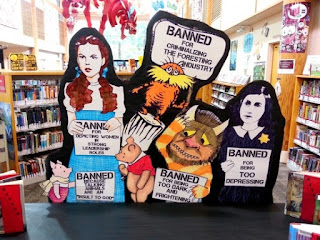Let's Talk About Project Two
Since we've started this class, my idea of writing and composing has changed a little bit, but not much. I still believe that writing can be considered composing, but composing has a main purpose being shared with an audience and writing is mainly meant for personal purposes. For example, I would write a grocery list, but I would compose a piece for my friends or peers to read. I believe that Project Two requires both elements. I wrote down plans for the execution of my project, but those were mainly for my own purpose. However, I turned those thoughts into my text that I decided to share with my audience. Project Two also caused me to think of new content and allowed me to create something of my own.
For my project, I decided to create a booklet from this assemblage:
In this text, six characters from banned books are present. Each of the characters are holding a sign with the word BANNED on it, following the reason why the book was banned. It is clear that the characters look confused or unhappy, and we can infer that they feel this way due to the fact that their books were banned. I feel that this assemblage, and my transformed text (booklet) is an example of effective communication and design due to the fact that the texts inform the audience about banned books and censorship, and are creatively designed at the same time. They allow the reader/audience to see something and interact with the text while learning about important subject matter.
Over the course of this year, we have been learning about key terms that relate to composition. The key terms that relate the most to the composition I've created are audience, design, exigence, and assemblage. Audience is a key word that is frequently used because we, as composers, are constantly trying to appeal to an audience. We want our audience to be engaged with our project. Design is a key word that is applicable because we were required to transform and remediate our assemblage. This requires us to incorporate different elements of design in order to aesthetically appeal to our audience. In order to produce a successful text, we must overcome exigence. The exigence of my project was the idea that my audience may not exactly know what banned books are or what censorship means. I wanted my audience to understand those terms by the end of my project. Assemblage is particularly prevalent in project two due to the fact that we had to initially find an assemblage and remediate that assemblage in order to produce a successful project two.
From project two, we can learn that reuse is something that occurs frequently when it comes to composing. Many ideas for "new" content come from old ideas, and the way that we design this new content is what makes it fresh and innovative.
For my project, I decided to create a booklet from this assemblage:
In this text, six characters from banned books are present. Each of the characters are holding a sign with the word BANNED on it, following the reason why the book was banned. It is clear that the characters look confused or unhappy, and we can infer that they feel this way due to the fact that their books were banned. I feel that this assemblage, and my transformed text (booklet) is an example of effective communication and design due to the fact that the texts inform the audience about banned books and censorship, and are creatively designed at the same time. They allow the reader/audience to see something and interact with the text while learning about important subject matter.
Over the course of this year, we have been learning about key terms that relate to composition. The key terms that relate the most to the composition I've created are audience, design, exigence, and assemblage. Audience is a key word that is frequently used because we, as composers, are constantly trying to appeal to an audience. We want our audience to be engaged with our project. Design is a key word that is applicable because we were required to transform and remediate our assemblage. This requires us to incorporate different elements of design in order to aesthetically appeal to our audience. In order to produce a successful text, we must overcome exigence. The exigence of my project was the idea that my audience may not exactly know what banned books are or what censorship means. I wanted my audience to understand those terms by the end of my project. Assemblage is particularly prevalent in project two due to the fact that we had to initially find an assemblage and remediate that assemblage in order to produce a successful project two.
From project two, we can learn that reuse is something that occurs frequently when it comes to composing. Many ideas for "new" content come from old ideas, and the way that we design this new content is what makes it fresh and innovative.

I like how you tie composing to rhetorical effect (audience-bound). I wonder, though, if we can produce something critically and thoughtfully yet not with the intent of impacting an audience, maybe just for ourselves?
ReplyDelete